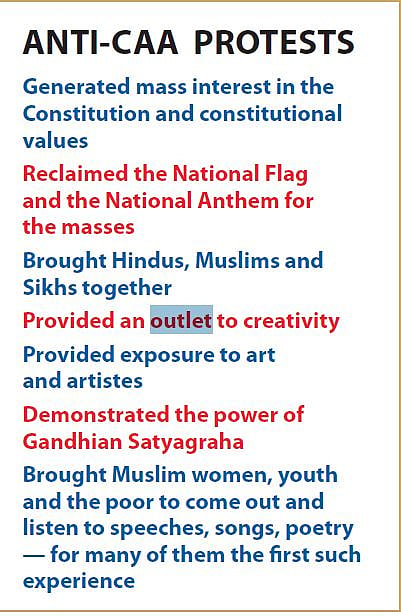Reporting from Ground Zero: first-person account from Delhi’s Shaheen Bagh
Two months ago nobody had heard of the obscure locality. Today it is not just a household name but it is drawing international attention after inspiring anti-CAA-NPR-NRIC protests across the country

Outside the main tent at Shaheen Bagh, Shan Mohammad in dark glasses is selling badges that read, ‘I love JNU, I love AMU, I love Shaheen Bagh’. Each badge for Rs 10. A large national flag is priced at Rs 50. Other bands which can be worn on the forehead say, ‘I love my India’ and ‘Reject NRC/CAA’ messages.
Hailing from Bulandshahar in western UP, he is listening to a Dilip Kumar song with his earphones from an old Subhash Ghai movie: 'Dil diya hai, jaan bhi denge, aie watan tere liye’. He says, “I love this song.”
In December, few had heard of Shaheen Bagh even in Delhi. In February, the obscure locality is not just a household name in India but it is drawing international attention after spawning similar anti-CAA-NPR-NRIC protests in cities across the country.


It was quiet at Shaheen Bagh on the morning of February 11, the day when the nation was agog with results of the assembly election. The women and a sprinkling of men sat silently with black arm bands. They refused to speak, indicating that they were supposed to remain silent.
At the Savitribai Phule-Fatima Sheikh library set up next to the protest site in a tent, there are books all over the place and a huge hoarding of a child teaching a man in uniform the meaning of the Indian Constitution.
A steady stream of scholars, filmmakers and activists, including Samina Mishra, Sohail Hashmi and Harsh Mander, have visited the library and delivered lectures. A Kashmiri scholar gave a lecture on Kashmir after the abrogation of Article 370. Young Muslim mothers are seen with their children at the library. “Knowledge is liberation,” says a graffiti on the wall.
The flyover across the street has become a running art gallery. There are hand-made posters of a galaxy of freedom fighters and revolutionaries. Bhim Army chief Chandraskhekar Azad's portraits seem to be a particular favourite. Azad is revered here because his campaign started with education among the deprived Dalits in Saharanpur and western UP, he is a hero to the resistance because he has suffered so much and has been arrested repeatedly by the police , imprisoned for long spells despite his ill-health, and also because of the video clips and images of him reading the Preamble to the Indian Constitution on the steps of the legendary Jama Masjid in front of tens of thousands of people.
There are Tricolours everywhere, and big posters and banners celebrating the Indian Constitution and its Preamble. There are huge banners, saying ‘Please don’t give cash, money or Paytm, etc. Please volunteer’. Volunteers make announcements if they need anything. Help pours in from different quarters.
The tent, mike, lights, etc are locally arranged. When artistes performed with Shubha Mudgal and others singing, they arranged everything. TM Krishna came and sang 'Hum Dekhenge' in four languages, and he arranged his own sound systems, volunteers claimed.
There are committed volunteers from the neighbourhood and outside who work invisibly but control the movement in a subtle and nuanced manner. They are mostly not seen, but they can be shopkeepers, young students, mothers or professionals. They manage the show from behind the curtain.
“The controversy about the blocked road is pure BJP propaganda,” quips a volunteer who has been working non-stop since the last two months. Two roads linking Delhi and UP on the highway are open. “Police have put up barricades there, we have not. We have in fact allowed ambulances and funeral processions to pass and have facilitated movement whenever we were asked. We blocked a small part of the road only for the security and safety of the women, many of whom spend the whole night out in the open,” he says.
“There have been three incidents of men coming with guns here. Besides, there are always agent provocateurs and goons who try to sneak in and create trouble, so we have to be extra careful, especially in the night. We have been lucky to figure out such people and politely asked them to move,” added another volunteer.
Across the library at the Guru Nanak Langar, under the flyover, there is hectic activity as food is being cooked in huge utensils. Two women of the neighbourhood, Saba and Noorjehan, are looking after the food. Don’t they need help? Oh, we will just get an announcement made and women will rush here to help. Hindus, Muslims, Sikhs and others, they all contribute in making the food.
Recently, Sikh farmers arrived from Punjab and helped out at the langar. The langar was set up by a Sikh philanthropist, DS Bindra, who sold off his flat to help run it. “I am ready to sell off another of my flats to continue the langar, if need be,” he is reported to have said. The vegetarian langar which serves regular meals to thousands has never faced scarcity. If they need, they just make an announcement: so much of dal, rice, vegetables and wheat are required etc, and the food just pours in from the people.
Auto driver Irshad Ahmed has not gone for work today. He has a profound message: “You might have beautiful shoes. You might have a beautiful and paved road. But if you have a stone in your shoe, the journey will always be difficult. Hence, this stone has to be removed.”
I see a young man coming with a huge quantity of bananas and several crates of oranges for the women protesting inside the tent. I also find biscuits being distributed at the site, accept one and bite into it.
Follow us on: Facebook, Twitter, Google News, Instagram
Join our official telegram channel (@nationalherald) and stay updated with the latest headlines
